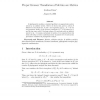BMCBI
2004
14 years 1 months ago
2004
Background: Research involving expressed sequence tags (ESTs) is intricately coupled to the existence of large, well-annotated sequence repositories. Comparatively complete and sa...
APPML
2002
14 years 1 months ago
2002
In phylogenetic analysis, a standard problem is to approximate a given metric by an additive metric. Here it is shown that, given a metric D defined on some finite set X and a non...
TCBB
2008
14 years 1 months ago
2008
Split networks are increasingly being used in phylogenetic analysis. Usually, a simple equal-angle algorithm is used to draw such networks, producing layouts that leave much room f...
IJBRA
2006
14 years 1 months ago
2006
: Phylogenetic analysis is a central tool in studies of comparative genomics. When a new region of DNA is isolated and sequenced, researchers are often forced to throw away months ...
BMCBI
2006
14 years 1 months ago
2006
Background: Phylogenetic analysis of large, multiple-gene datasets, assembled from public sequence databases, is rapidly becoming a popular way to approach difficult phylogenetic ...
ALGORITHMICA
2006
14 years 1 months ago
2006
Phylogenetic analysis is an area of computational biology concerned with the reconstruction of evolutionary relationships between organisms, genes, and gene families. Maximum likel...
ALMOB
2007
14 years 2 months ago
2007
Background: Some amino acid residues functionally interact with each other. This interaction will result in an evolutionary co-variation between these residues – coevolution. Ou...
CSB
2005
IEEE
14 years 7 months ago
2005
IEEE
Peptide compositions constructed out of whole sets of protein sequences can be used as species signatures for phylogenetic analysis. To account for point mutations, an amino acid ...




